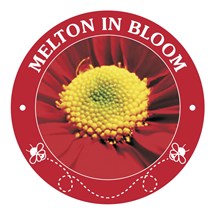Melton in Bloom
Melton in Bloom was formed in 2007.
They cover all of the town of Melton Mowbray and work with the local community groups, schools, businesses and public sector organisations across the area.
Whilst continuing to maintain their previous achievements, the group are working towards giving new life to grey areas, grot spots and dead spaces within the town. The work they carry out helps to create multiple green areas for the enjoyment and wellbeing of everyone living, working and visiting Melton Mowbray.
The group takes environmental responsibilities very seriously and encourages the support of local conservation, bio diversity and the protection of wild life habitats throughout the area.
Melton in Bloom are always looking for more volunteers to join them, if you are interested then please email meltoninbloom@hotmail.co.uk.
Melton in Bloom locations around the town:
Flower Beds and Gardens around Melton Mowbray
Location: These beautiful and restful gardens are located on the junction of Leicester Road, Leicester Street and Wilton Road and accessed through a gate to the left of Egerton Lodge Care Home.
The significant memorial features of the gardens include two Victoria Cross beds; one in sunset colours and the other representing sunrise, using inspiration from Laurence Binyon’s poem, For the Fallen: ‘At the going down of the sun, and in the morning, we will remember them.’
The planting scheme was designed by Melton in Bloom and is maintained by Melton Mowbray Town Estate, in honour of two Victoria Cross recipients with connections to Melton: Captain Paul Kenna and Lieutenant The Honourable Raymond Harvey Lodge Joseph De Montmorency.
The terrace area features various commemorative plaques.
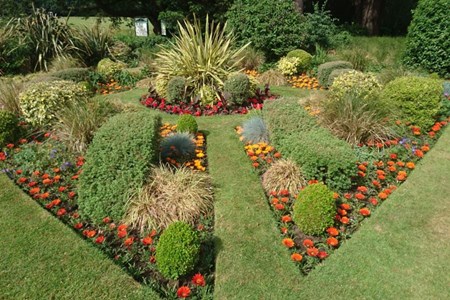
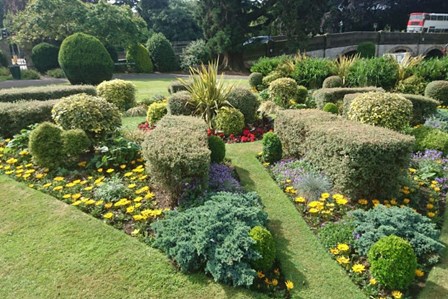
Location: 7 King Street 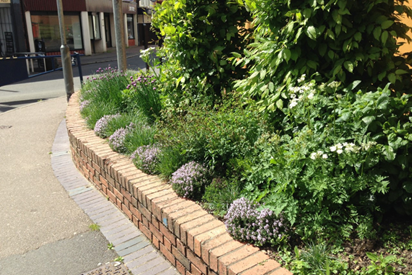
Behind the Victorian shop fascia of 7 King Street lies the medieval manor house built in 1330 for John de Mowbray. It is even older than the Guildhall in Leicester. This small garden is a snapshot of the sorts of herbs and features that would have been found in John’s garden in the fourteenth century.
Every Manor House had an herb garden. Herbs were vital for medicines, deterring lice and fleas, scenting the air when often bad smells were overwhelming, for the preservation of foods and flavouring for cooking and for making dyes for cloth. Herb beds were often raised up from the ground by a low wall to help drainage. Herbs thrive in a sunny well drained soil. Many of them were brought back by the knights returning from the Crusades so they come from a warm Mediterranean climate.
Location: Melton Country Park, near the Visitor's Centre Café, accessed through Wymondham Way, LE13 1HP.
As the name suggests, this site is a peaceful, sheltered area. The garden is a retreat open to everyone visiting, using and working in this part of the park. It is a place to enjoy the relaxing atmosphere, sights, smells and sounds of nature.
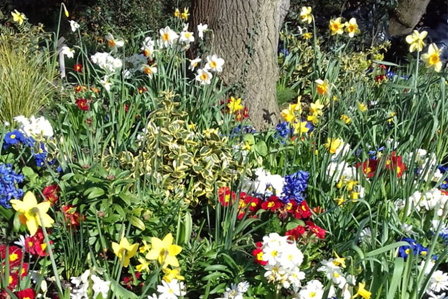
Location: The corner of Wilton Road and Park Road, opposite the Library.
Until a few years ago, this lovely corner bed was a bit of a grot spot! Melton in Bloom took it under it’s management and with a very kind donation, it is now a mass of colour and interest. It is a small area but one that is not to be missed.
Heritage Gardens
Location: Located on the old river basin in front of the Council Offices and the entrance to Melton Town Park.
Melton in Bloom volunteers have worked on the Heritage Beds since Melton in Bloom was first formed. When these beds were conceived they were taken on by various businesses and local groups, but over recent years Melton in Bloom have carried out a huge amount of gardening maintenance here with the support of the Council who provide the funding of the planting of these beds.
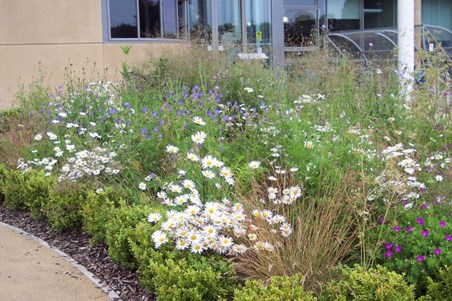
The Melton area is well known for its farming history, and the wool trade brought wealth to the town. Local milk was made into Leicester and Stilton cheeses and the whey was used to feed pigs, which led to the production of our famous pork pies. These have helped to make Melton the Rural Capital of Food.
The border is full of wildflowers, some named after farm animals, together with a vintage plough and sculpture of a resting lamb.
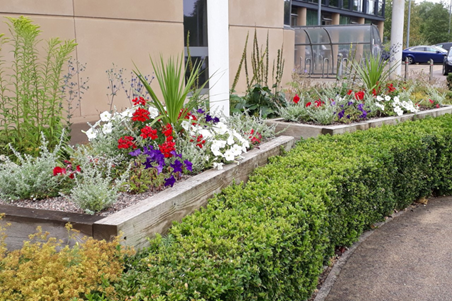
The Flag Border contains two raised beds, which are dedicated to the Armed Forces.
The raised beds have colourful container plants, and perennials mixed with native wildflowers at ground level help to encourage lots of insect life and are focus of annual Armed Forces Day ceremonies.
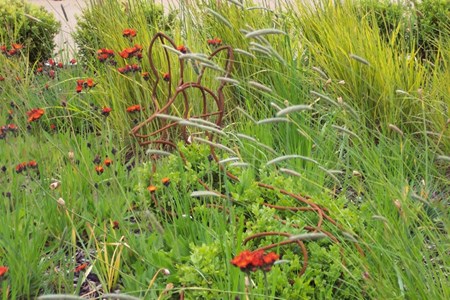
Fox hunting played a major part in Melton’s history and during the 1800’s the town was considered the ‘capital’ of the fox hunting scene.
This attracted dignitaries and royalty from all over the world. The border has sculptures of a mother fox and her two cubs, nestled among mainly fox-themed planting such as Rose White Fox and Thymus Foxley.
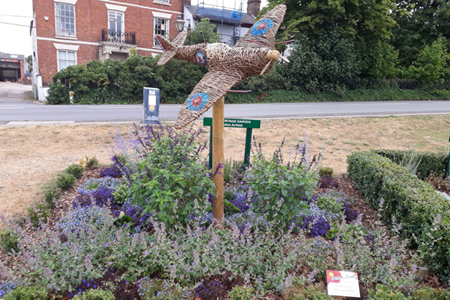
The Airfield, on Dalby Road, was of major importance during the Second World War and the Cold War.
During the Second World War, residents from Melton and some of the surrounding villages raised money to buy a Spitfire plane to help with the war effort and a willow sculpture of a Spitfire is the centrepiece of the bed.
The planting is in shades of blue, representing the colour of the RAF’s uniforms.
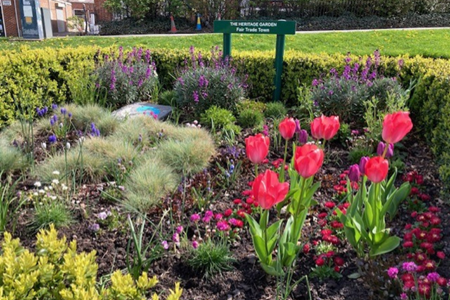
The Melton Fairtrade Group promotes fair trade in Melton, and they replanted their bed to celebrate Kings Charles III's coronation. C R III is spelt out in colourful grasses and flowers, to make a lovely display.
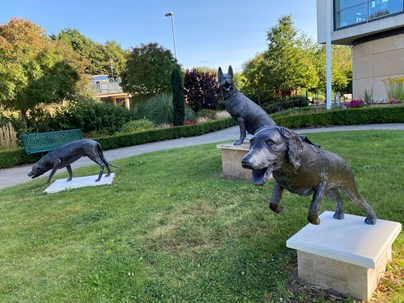
The three different sculptures, created by Lloyd le Blanc, are dedicated to all the dogs who have been trained by the Defence Animal Training Regiment on Asfordby Road in Melton, and have gone on to work tirelessly to support the Armed Forces.
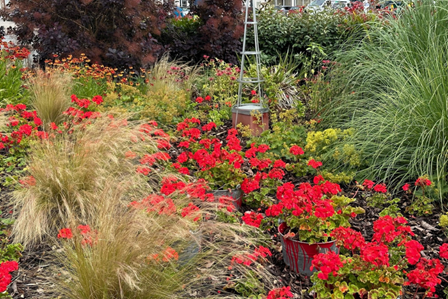
It's been said that the phrase "Paint the town red" originated in 1837, when the Marquis of Waterford and several drunken friends daubed red paint on a number of prominent buildings, including the famous Swan Porch in the Market Place, Melton Mowbray.
This flower border contains many red plants, buckets filled with flowers representing paint pots, and grasses with ornamental heads representing the paintbrushes.
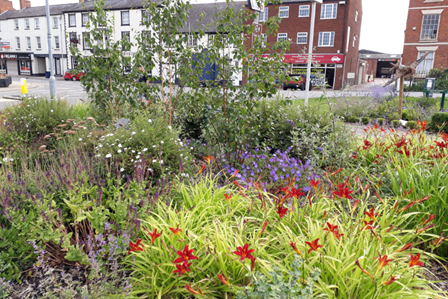
Melton has extensive historical links to royalty, going back centuries. Bordering the nearby park we have the Kings’ Highway footpath, which leads from the railway station to St Mary’s Church.
The flower bed along this route, has recently been re-dedicated to Queen Elizabeth II’s Platinum Jubilee, when three multi-stemmed Himalayan birches were planted as part of the ‘Queen’s Green Canopy’ initiative. Other planting is in shades of red, white and blue.

This border is dedicated to the railways, which effectively took over from the moving of goods by canal. Railways first came to Melton in the 1800’s, with two stations – Melton North, which closed in the 1960’s and Melton Town, which is situated nearby this border.
The centrepiece of this border is a miniature train, created for Queen Elizabeth II’s Platinum Jubilee, and is fronted by colourful dwarf mixed planting.

The Melton Navigation (an old canal) led to this area, where a small boat basin stood during the 1800’s, receiving horse-drawn barges with various goods.
A ‘one-third’ scale canal boat is the centrepiece of the border, with a canal scene surrounding it.
The bed includes lots of colourful planting, and a bank of nectar rich plants, wildflowers and grasses to mimic waterside planting.
St Mary's Church
The borders are a wildlife haven, with lots of plants being pollinator-friendly and plenty of scope for small wildlife to shelter. Wildflowers have been used in a neighbouring north border, to add to our biodiversity, and we also now have composting facilities.
In early 2010 a ‘Snowdrop Appeal’ launched by one of our volunteers proved so popular that we received donations from as far away as Holland, with further donations still being brought in up to a year later.
In 2011 the church volunteers and Melton in Bloom were awarded the John Porter Rose Bowl for all their efforts.
The church is a regular entrant into the ‘It’s Your Neighbourhood’ category of East Midlands in Bloom, and has achieved several levels of award, including the highest level 5.
You can view the flower beds below, starting at the main entrance on Church Street and going around the Church in an anti-clockwise direction.
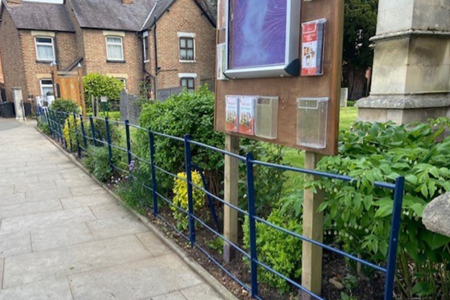
The Traditional borders are situated either side of the west door, the main one being to the left, with a smaller curved section to the right.
As well as being ornamental, to provide a welcoming approach to the church, the plants chosen represent a cross-section of Church/British tradition and history, in one form or another. Whether this is by being native or naturalised species, common churchyard flowers or garden favourites, having links to the Monarchy, plants used to represent religious festivals such as Christmas and Easter or colouring that represents Christening, Marriage and Mourning.
Plants include evergreens, shrubs, dwarf conifers, roses, perennials, grasses, ferns and spring/summer flowering bulbs.
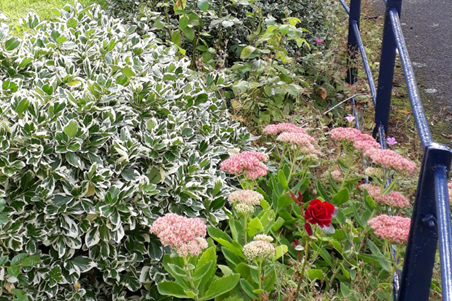 The Remembrance borders are situated to the south side of the church.
The Remembrance borders are situated to the south side of the church.
The first border was planted after a group of parishioners, who wanted to do their bit for the environment, got together to create an Eco-Team. This Eco-Team went on to win a ‘Green Award’, taking home a garden voucher as their prize.
Together with Melton in Bloom, the Eco-Team chose suitable plants for this location, in order to provide year-round interest, shelter for wildlife and a pleasant environment for visiting mourners. Spring bulbs and bedding plants were donated at a later stage and donations still continue on a regular basis from parishioners and residents.
The second border, to the right of the south door, had initial planting funded by a parishioner in memory of her late husband. Since then, further plants have been donated by various people, to add yet more interest to the scheme.
The fourth Melton Mowbray (St Mary’s Church) Brownies had a very enjoyable time planting lots of spring bulbs in the Remembrance Borders, followed by a reception with lots of goodies as a reward for all their hard work.
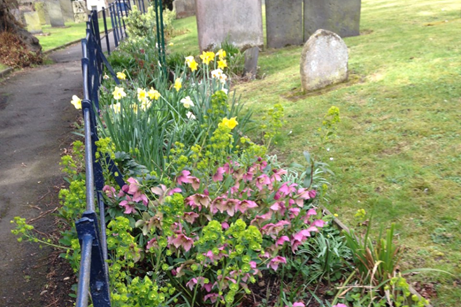
The Woodland Border is situated next to the second Remembrance border.
The large swathe of existing bluebells within the border inspired the idea of a woodland theme. A selection of shade-loving plants has been chosen, to provide year-round interest and colour.
Feature plants include a selection of ferns and some lovely hellebores.
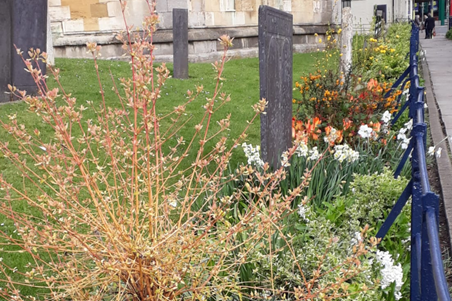 This border is situated to the east side of the church and is inspired by the story of Noah and the Great Flood. The theme of a rainbow colours comes form the bible verse, God’s covenant with Noah: Genesis 9:1-17: ‘I have set my rainbow in the clouds, and it will be the sign of the covenant between me and the earth.’
This border is situated to the east side of the church and is inspired by the story of Noah and the Great Flood. The theme of a rainbow colours comes form the bible verse, God’s covenant with Noah: Genesis 9:1-17: ‘I have set my rainbow in the clouds, and it will be the sign of the covenant between me and the earth.’
Along the length of the flower bed, you can see all seven colours of the rainbow, interspersed with patches of white, to represent the clouds.
Plants include shrubs, dwarf conifers, clematis as scramblers, perennials and ornamental grasses.
Further interest is provided by spring and summer-flowering bulbs, with pockets of spring and summer bedding. Some winter colouring is also present, with various types of evergreen plants and shrubs with coloured stems.
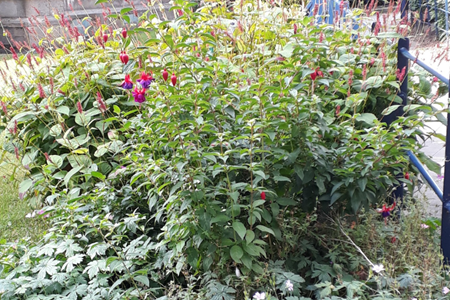 Situated to the north side of the church, this border features a lovely mix of plants and bulbs.
Situated to the north side of the church, this border features a lovely mix of plants and bulbs.
All of the plants in this garden came from donations by members of the congregation and other volunteers or by the Bishop of Leicester from his residence.
Melton in Bloom and church volunteers held a mass planting session and filled the entire bed in the space of a few hours.
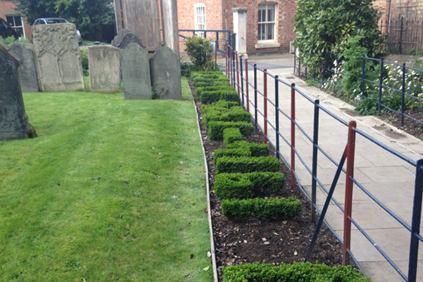
Situated to the north side of the church, this bed is a tribute to Sir Malcolm Sargent, the famous conductor, organist and composer who was organist at St Mary’s from 1914 to 1924.
The border planting is in the form of topiary, with a variety of musical notes and the dates Sir Malcolm was with the church.
This brings us back to the corner near the main entrance, where the Traditional borders begin.
